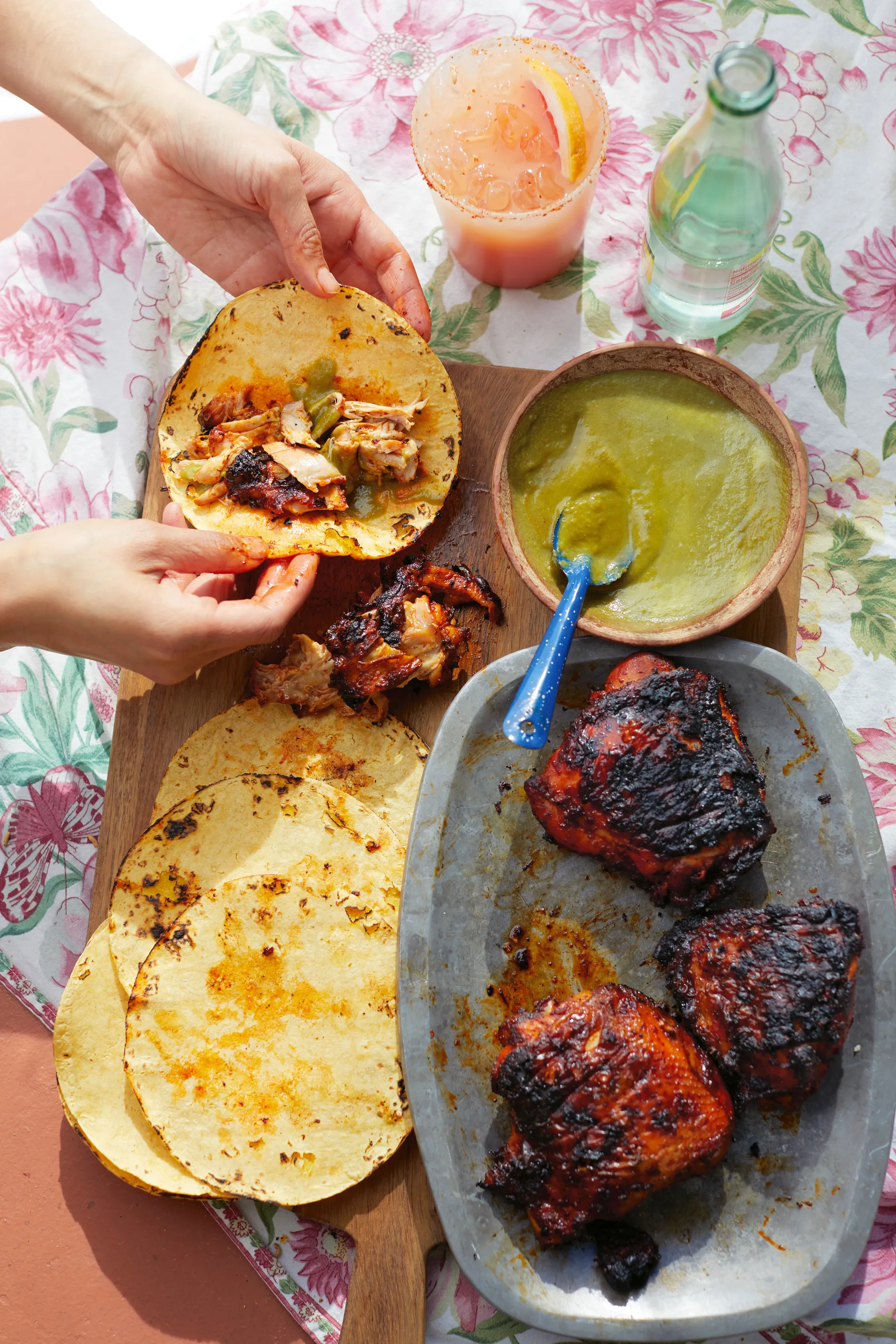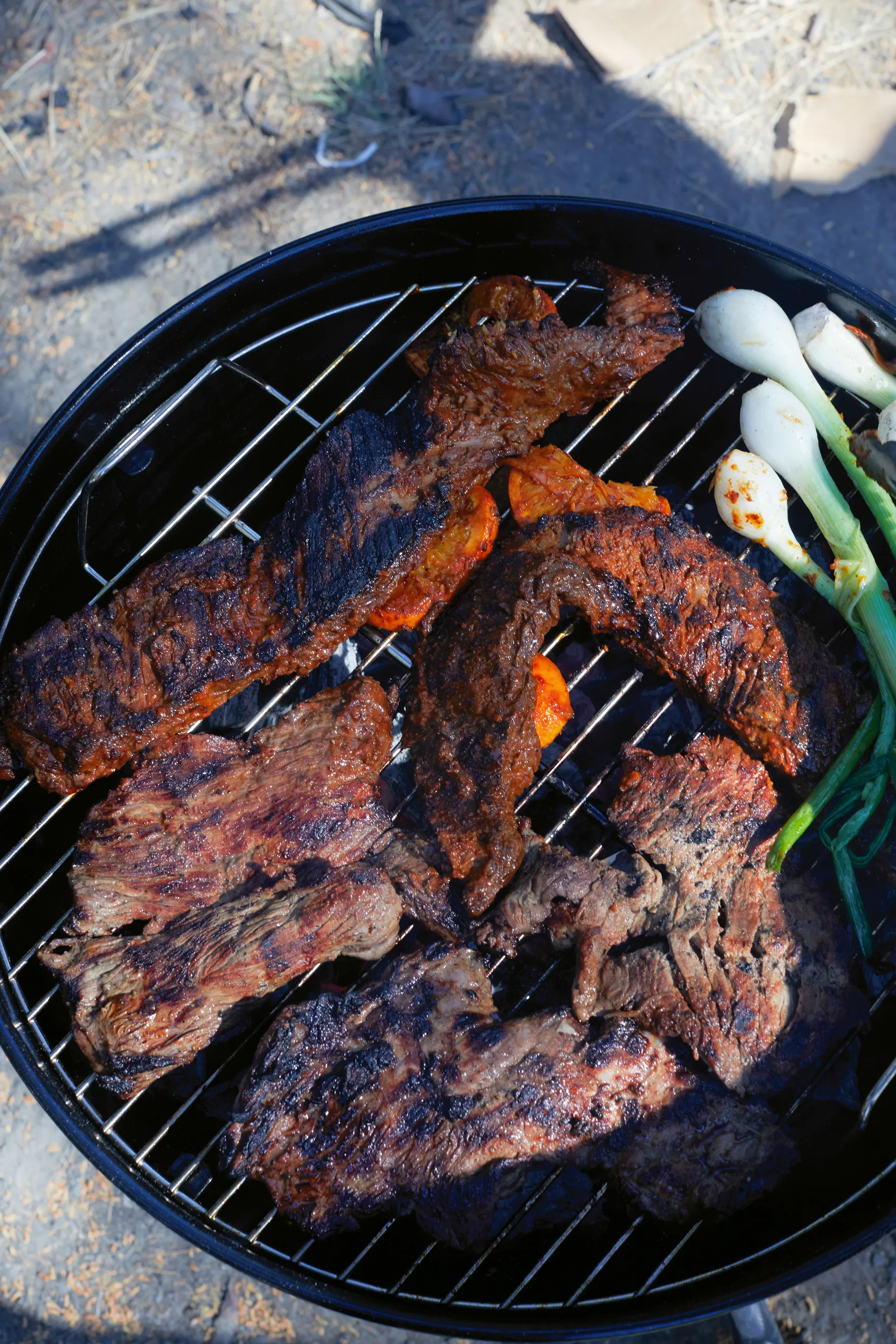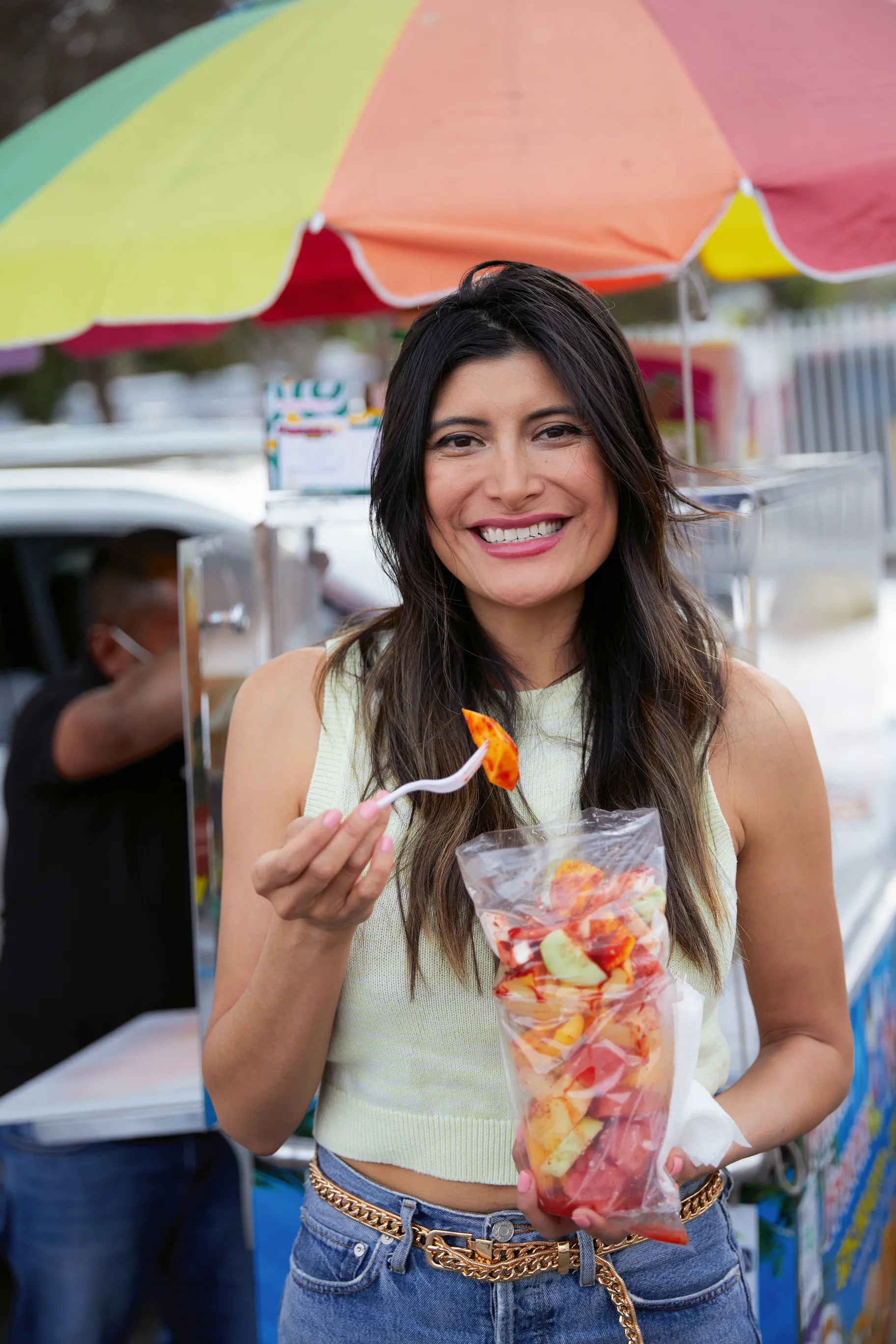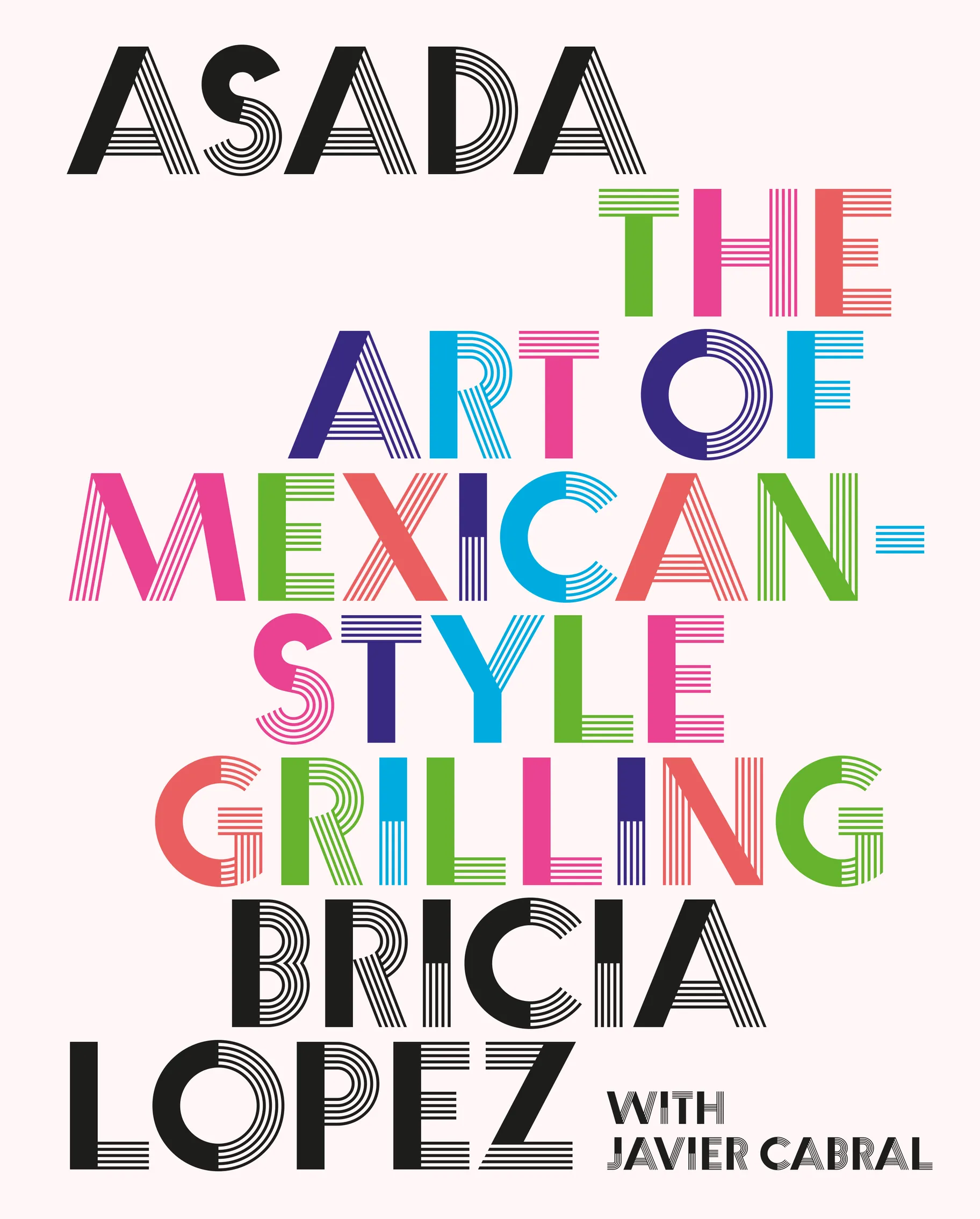Carne asada is more than a taco filling. In Los Angeles, it's a way of life. Bricia Lopez holds court at Guelaguetza in Koreatown, the Oaxacan restaurant her family opened in 1994. Javier Cabral is the editor of LA Taco. As a follow-up to their 2019 cookbook "Oaxaca: Home Cooking From the Heart of Mexico," the duo return with an ode to festive gatherings, starring backyards across Los Angeles: "Asada: The Art of Mexican-Style Grilling."
This following has been edited for length and clarity.
KCRW: What differentiates the carne asada that we most frequently associate with a taco from the asada that you're talking about?
Javier Cabral: Carne asada at a restaurant sometimes is not mesquite-grilled. They call it carne asada, a steak that is seared on a plancha. That's how far carne asada has traveled from its origins. Whenever you cook it at home, a carne asada cannot exist without fire, without mesquite, without a grill in the back. So the difference between carne asada at a restaurant and your backyard is essentially [cooking it with] fire versus grilling it on a plancha.
Does the word "asada," like saying that you're going to an asada, basically mean you're going to a backyard barbecue?
Cabral: Yes, you nailed it.
Bricia Lopez: It means you're going to a party.
Cabral: A hang, a kickback.
Lopez: Because sometimes it can be at a park. If you are Latino growing up in LA, when you hear “asada,” the first thing in your mind isn't a taco de asada, it's the gathering of your family and your friends and your loved ones, either in your backyard, in the park, all around LA, or maybe in the back of your apartment building.
I grew up in an apartment building, and everybody would get together in the building's sort of hub, downstairs, the parking lot. Someone would set up a grill and just have an asada with loved ones. So it's just a gathering of friends and really revolves around food, but it's about family, friendship, and this state of mind.
I love that in the book, you have a line that reads, "The smell of asada is an invisible cloud of joy that forever lingers around the streets of Los Angeles."
Lopez: That's the asada mindset I'm talking about.

Just because it's an asada doesn't mean it has to be all beef. This pollo in guajillo is a favorite grilling recipe. Photo by Quentin Bacon.
Could you share a bit of history of when asadas became popular in Mexico?
Cabral: In Mexico, it's always been a thing, I think, since the early 1900s, since the first Spanish conquistadors arrived to the north of Mexico and brought their meat-eating and wheat-eating ways to Mexico. The asada culture of Mexico is mostly the strongest in northern regions, in states like Nuevo León, Sonora, and Sinaloa in Baja California. It really is like a form of expressing love there. It's much more than just a taco or a nourishment. It's a real intangible pastime there.
What meat cuts work best for carne asada, and what are some of your favorite carnicerias are around town?
Cabral: The most common cut for carne asadas in LA is flap meat, which is a bit of an extension on the skirt steak. It's not a thick steak. It's just thick enough to grill and be able to hold high heat, and if it gets a little overdone, it's still very juicy and delicious. It's also very beefy in flavor.
Aside from that, you have your flanken ribs. They're the first to disappear at a carne asada. Those are the bone-in cut that's also associated with kalbi ribs. In Spanish, you call that the costillitas. Those two are the strongest, but people love chicken. Pollo asado, marinated chicken, is a big cut that deserves some respect in carne asada culture because not a lot of people eat red meat for specific reasons and grilled chicken is also really big.

Thin-sliced beef gets the perfect char on a grill. Photo by Quentin Bacon.
It used to be a preference, whenever I would go and be part of an asada, that the meat is always well cooked. Does that continue to be true?
Lopez: 100%. Here's what I always tell people: What I love about Mexican carne asadas, or just asadas in general, is that food doesn't have to be precious. Food just is. And there are no rules for us, especially me, my family, specifically my sisters. They will wait until they have the char on the meat, where it's crispy and extra burnt on the sides. And you know the whole medium, well, rare — all those words don't exist. The use of a fork and a knife, the cut against the grain... all those nuances that we are taught here in America when it comes to meat coming from steakhouses, go out the window.
For us, it's about eating with your hands, eating it crispy, almost burnt, tearing the meat with your hands, shredding it, just grabbing a tortilla, no fork, no knife, and just being one with the meat and not being so precious about it. I think that is what I love about carne asada so much.
Cabral: One of my favorite moments is when you just grab a piece of meat. Because normally, when you grill them off the fire, you collect them in a pot of some kind with a cover on it, so that after grilling them, they get a little juicy and extra steamy. There's no chopping into small pieces. You literally grab it with your hands and put it on a tortilla and you just take a big, powerful bite.
I'm a person who really loves cartilage and crispy edges, the part that's closest to the bone. And this is my favorite part about a carne asada.
Bricia Lopez: This is also why we love flanken ribs, because you can just get that close-to-the-bone edge. Crispy but there's still some fatty edges, as well. It's the ultimate. I've been having a lot lately and let me tell you, you just can't get enough.
Bricia, did your family have a secret asada recipe that they would pull out at every backyard-do? Are there any special ingredients specific to Oaxaca that your family used?
Lopez: Yeah. … For us, it was always tasajo, which is a very, very thin round cut that's only salted. And we have cecina, which is a very thin pork that has been marinated, like enchilado almost, so it has vinegar and chiles and it's a red sauce that's layered on top of it. And chorizo. So in Oaxaca, those are the three meats that we eat — tasajo, cecina, and chorizo — when we have our asadas.
I have my Oaxaca side, but I'm also an LA girl. So my LA in me, it's really me finding my asada recipe and my asada flavors. The recipes that we have in the book are just recipes that I developed myself while hosting Fourth of July carne asadas at home.

Bricia Lopez helps run Guelaguetza, the restaurant her family opened in 1994. Along with Javier Cabral, editor of LA Taco, she wrote the book "Asada: The Art of Mexican-Style Grilling." Photo by Quentin Bacon.
What's in a classic carne asada marinade?
Lopez: In a carne asada classica, there will always be citrus and there will always be onion. There will always be oregano, cumin, and a few other spices in there. Lots of salt, always. I think a lot of people, they get scared. For me, it's just always very important that the meat is very well seasoned. My rule of thumb is always a tablespoon of sea salt per pound of meat. Don't be afraid and season it very well. Then add the rest of the ingredients for a marinade.
Is preparing an asada kind of like Thanksgiving, where preparation has to begin days, if not weeks, in advance?
Lopez: No, no, no. Not at all. Asadas are easy. Asadas are meant to bring people together without the stress of having to do this crazy, over-the-top meal. That's one thing I love about asada, is that you don't have to have a tablescape and you don't have to have fancy china or any decor or these wonderful plate settings. In fact, most of my book was shot in actual asadas that I had at the park and in my backyard. I remember a prop stylist asking me what plates I wanted, and I was like, "I don't know. Get plastic ones." These are the ones that I use when I have asada at home. We don't have to have fancy plates.
As far as prep for food, I think the only prep that I've ever done for an asada, it's maybe soaking my beans. … But I feel like maybe that's as far as I go. Maybe do a salsa the day before. But other than that, it's just marinating the meat. That, I can do in the morning and then you bring it out while it's marinating, let it come to temperature. I love grilling at room temperature. Cut up some cheese. Go buy some chicharon, make your sauces that are quickly eaten, rice, beans, and you have a party.
Bricia, can you break down your recipe for Pollo in Guajillo, which you got through many long days working at Guelaguetza, for those looking for something great with chicken?
Lopez: Yeah, so this guajillo chicken for me was very much influenced by a cecina that we have at Guelaguetza, which is the the thin pork that I was talking about earlier, with lots of guajillo pepper, some cinnamon, which is also what's in your marinade, vinegar. It just adds to these hints of smoke, spice, citrus, and, of course, salt that makes for great, wonderful, juicy chicken that you always want to have. It's always a hit. Chicken's always hit.
Pollo in Guajillo
Serves 4
This grilled chicken has gotten me through so many long days working at Guelaguetza. There were time when I ate it for lunch every day, sometimes with a big salad, sometimes with homestyle french fries, or with rice, beans, and tortillas. It tastes great any way you eat it and it reheats beautifully. This is a solid recipe to make on a Sunday and eat throughout the week. I purposely did not soak the chiles, in order to create a rustic marinade that has more texture; the flavor of burnt chile once it is grilled makes this chicken recipe stand out.
Ingredients
- 12 guajillo chiles (1¾ ounces/50 g), stems and seeds removed
- ½ large white onion
- (5¼ ounces/150 g), roughly chopped 8 cloves garlic, peeled
- ¼ teaspoon black peppercorns (about 12 peppercorns)
- 1 whole clove
- 1 tablespoon dried Mexican oregano
- 2 tablespoons grapeseed oil
- ¼ cup (60 ml) orange juice
- 2 tablespoons seasoned rice vinegar
- 2 tablespoons fresh lime juice
- ¼ teaspoon ground cinnamon
- 1½ tablespoons sea salt
- 2 pounds (910 g) bone-in chicken thighs
Instructions
- In a cast-iron skillet over medium heat, lightly toast the chiles, about 2 to 3 minutes on each side. Remove from the skillet and set aside.
- In the same skillet, add the onion and garlic, turning once or twice until they are lightly charred, about 10 minutes. Remove from the skillet and set aside.
- Add the peppercorns, clove, and dried oregano to the pan and lightly toast until they are aromatic, about 2 minutes. Transfer the toasted spices and oregano to a molcajete or spice grinder and grind until finely ground.
- In a high-performance blender or food processor, add the toasted chiles, onion, garlic, ground spices and oregano, oil, orange juice, rice vinegar, lime juice, cinnamon, and salt. Blend until most of the chiles have come apart.
- Pat the chicken dry with paper towels. Using a gallon-size resealable bag, add the marinade and the chicken. Seal and let sit in the refrigerator for at least 30 minutes or overnight.
- Remove the chicken thighs in their marinade from the fridge to allow them to reach room temperature before grilling.
- Start a charcoal or gas grill. The gas should be set to high. If using a pellet grill, preheat your grill to 450°F (230°C) for at least 15 minutes. If using charcoal, the coals should be red but entirely covered with gray ash. Remove the chicken from the marinade and put them on the grill directly over the medium fire, skin side up. Close the lid and cook, turning once, about 15 minutes on each side. The chicken is cooked when its internal temperature reaches 175°F (79°C) on a meat thermometer. Transfer the meat to a cutting board and let rest for 5 minutes.
Excerpt from the new book "Asada: The Art of Mexican-Style Grilling" by Bricia Lopez and Javier Cabral. Copyright (c) 2023 by Bricia Lopez and Javier Cabral. Photos copyright (c) 2023 by Quentin Bacon. Published by Abrams.
Javier, corn or flour tortillas?
Cabral: Both. There is space in your belly for both, always. Recently, I've been on a flour tortilla kick with Northern Mexico being a part of the region that asada is really inspired from. We actually have a recipe in the cookbook for a really good avocado oil flour tortilla inspired by a notable tortilla maker out of Lawrence, Kansas. But yes, always corn and flour both, and even tostadas too. Sometimes you need a little crunch.
Lopez: I'm gonna tell you something. I'm from Oaxaca, and I'm a corn tortilla girl to my core. My husband has been a flour person all his life, because he's a northern guy. But these past few months, I've just been on a flour tortilla kick. And now that's probably what I consume most at home. Here in LA, Mejorado has great flour tortillas that I buy down the street from my office.
Let's talk about nopales, which are a great vegetable counterpoint to a super meaty menu. Is there a way that you prepare it or that you navigate around its natural sliminess, which some of us love but might be kind of off-putting for others?
Lopez: The best way to do that is you lay out your cactus, your whole cactus paddle, and then you salt it and let it sit there for a bit. Then all the gooiness will sort of come out, almost like you would an eggplant. Then you just put it directly on the grill, and you're good to go.
Describe the meat-on-meat bone marrow salsa you feature in the book. Where did you get that inspiration?
Lopez: It's really, really, really good.
Cabral: That salsa, the portono, which is our bone marrow salsa, is inspired by Monterrey, Nuevo León, [where] there is a kind of viral or popular taco style there that is an arrachera, which is skirt steak. The recipe that we have is not that. We did it our own way, because theirs is a lot more stripped down, with just chiltepin chile and lime juice.
Ours is a little more nuanced, but it is rich and buttery in a very bovine kind of way. When you're at a carne asada, your hair's gonna smell like smoke, your lips are gonna be full of collagen, your stomach is gonna be really full of a bunch of meat and booze. So this is another way of turning up the excess in the most delicious way imaginable. You will not forget it.
And with that, I am officially starving.
Citrus and Spice Costillitas
Serves 4
This recipe is inspired by the iconic Mexican flavor combo found in so many candies and packaged marinade powders: dried chile and citrus. Now you can make your own. You can double or quadruple the yield and keep any leftover spice mix—before adding the juice—in a container with a tightly fitting lid, in your pantry, for later. Chile-citrus powder adds a punch of flavor to anything it touches, including potatoes, chicken, and pork.
Ingredients
- 1 teaspoon guajillo chile powder
- 1 teaspoon smoked chipotle powder
- 1 teaspoon ground cumin
- ½ teaspoon onion powder
- ½ teaspoon garlic powder
- ½ teaspoon dried cilantro
- ¼ teaspoon dark brown sugar
- 1 teaspoon soy sauce
- Zest and juice of 1 lime (about 2 tablespoons)
- Zest of ½ large orange
- Juice of 2 large oranges (about ¾ cup/180 ml)
- 2 pounds (910 g) flanken beef ribs
For serving:
- Warm tortillas (preferably homemade)
- Salsa of your choice
Instructions
- In a bowl, add the guajillo powder, chipotle powder, cumin, onion powder, garlic powder, dried cilantro, brown sugar, soy sauce, lime zest and juice, the orange zest, and the orange juice. Whisk to combine.
- Pat the meat dry with paper towels. Using a gallon-size resealable bag, add the marinade and the meat. Seal and let sit in the refrigerator for at least 30 minutes or overnight.
- Remove the steaks from the fridge to allow them to reach room temperature before grilling, if possible. Start a charcoal or gas grill. The gas should be set to high. If using a pellet grill, preheat your grill to 450°F (230°C) for at least 15 minutes. If using charcoal, the coals should be red but entirely covered with gray ash.
- Remove the steaks from the marinade and put them on the grill directly over the fire. Close the lid and cook, turning once, about 4 to 5 minutes on each side. Transfer the meat to a cutting board and let rest for 5 minutes. Slice the meat against the grain. Serve with warm tortillas and salsa.
Excerpt from the new book "Asada: The Art of Mexican-Style Grilling" by Bricia Lopez and Javier Cabral. Copyright (c) 2023 by Bricia Lopez and Javier Cabral. Photos copyright (c) 2023 by Quentin Bacon. Published by Abrams.

"Asada: The Art of Mexican-Style Grilling" offers a wealth of recipes for grilled meats and salsas as well as starters, sides, salads, aguas frescas and sweets. Photo courtesy of Abrams.
